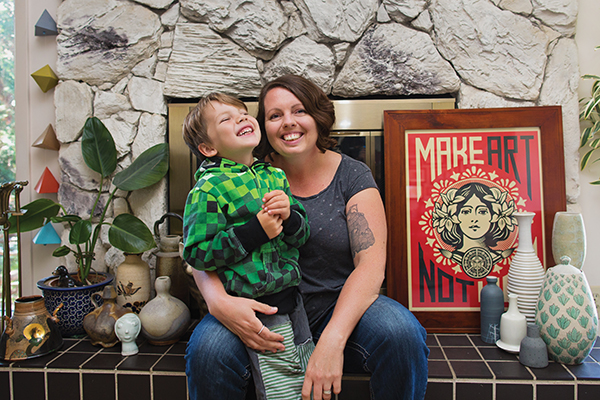In this Artist Q & A, we're featuring Canadian potter Carole Epp. The editorial staff of Ceramics Monthly and Pottery Making Illustrated, chose Carole as 2017's Ceramic Artist of the Year for making work that reflects current aesthetics, and for setting an example for ceramic artists by embracing current trends, technology, studio, marketing, and/or community-focused practices. Here's a little more about Carole in her own words. –Jennifer Poellot Harnetty, editor
Editors: What is the most important thing that has happened in your career so far and why?
Carole Epp: There have been numerous turning points so far in my career, things that have changed my perspectives on making, others that have simply been key moments, and mentors who reassured me that I was on the right path. But motherhood, well it changed absolutely everything. My world view shifted, and my need to be a better, more truthful, advocate for positive change in the world (a key component of my art) took on new levels of meaning.The figurative work I produce is politically inspired and activist in its motivation.
There is an onus on you to act when bringing children into a world that you believe needs a major overhaul and shift away from systems of oppression, capitalism, environmental destruction, violence, and injustice. The commentary my work had in the past is ever more pertinent and passionate when I’m fighting the battle for a better world for my own children.
As much as the work has intensified, it has also found more humor and sometimes a less confrontational means of addressing content. Myfunctional line of work has shifted as well, incorporating imagery and surface decoration for the first time. Whimsy, familiar narratives and happy faces adorn the work to remind those who use them of positive aspects of life and what’s worth fighting for in our world. Motherhood also forced me to prioritize and accept a different pace of creating and degree of experimentation. I’m now far more appreciative of how integral making art is to my identity and purpose as an individual.
Eds: Do you feel that your identity as a maker and perspective on making a living as an artist changed over time? If so, how?
CE: The process of acknowledging and claiming the title of artist has been a slow evolution for me. Art as a career and art as a vocation/way of life are not simple phrases that I use half-heartedly. The boundaries between art and life, or my art and my identity, have blurred over time to the point of non-existence. It wasn’t until that point of assimilation that I felt like I was truly an artist. Part of this acceptance has been the evolution of what my career encompasses. A maker does not simply make; they research, they explore market trends and sustainability, they pay bills and take care of shipping and receiving, they curate, and they collaborate. I don’t have work time versus home time. I have learned to live and breathe the notion of being an artist into everything that I do. This allows me to be more truthful in my work, more vulnerable, open to failure as a byproduct of experimentation; and more all-encompassing in my creativity.
Search the Daily
Published Mar 1, 2017
Editors: What is the most important thing that has happened in your career so far and why?
Carole Epp: There have been numerous turning points so far in my career, things that have changed my perspectives on making, others that have simply been key moments, and mentors who reassured me that I was on the right path. But motherhood, well it changed absolutely everything. My world view shifted, and my need to be a better, more truthful, advocate for positive change in the world (a key component of my art) took on new levels of meaning. The figurative work I produce is politically inspired and activist in its motivation.
The figurative work I produce is politically inspired and activist in its motivation.
There is an onus on you to act when bringing children into a world that you believe needs a major overhaul and shift away from systems of oppression, capitalism, environmental destruction, violence, and injustice. The commentary my work had in the past is ever more pertinent and passionate when I’m fighting the battle for a better world for my own children.
As much as the work has intensified, it has also found more humor and sometimes a less confrontational means of addressing content. Myfunctional line of work has shifted as well, incorporating imagery and surface decoration for the first time. Whimsy, familiar narratives and happy faces adorn the work to remind those who use them of positive aspects of life and what’s worth fighting for in our world. Motherhood also forced me to prioritize and accept a different pace of creating and degree of experimentation. I’m now far more appreciative of how integral making art is to my identity and purpose as an individual.
Eds: Do you feel that your identity as a maker and perspective on making a living as an artist changed over time? If so, how?
Unfamiliar with any terms in this article? Browse our glossary of pottery terms!
Related Content
Ceramic Artists
Functional Pottery
Ceramic Sculpture
Glaze Chemistry
High Fire Glaze Recipes
Mid-Range Glaze Recipes
Low Fire Glaze Recipes
Ceramic Colorants
Ceramic Glazes and Underglazes
Ceramic Raw Materials
Pottery Clay
Ceramic Decorating Tools
Ceramic Kilns
Making Clay Tools
Wheel Throwing Tools
Electric Kiln Firing
Gas Kiln Firing
Raku Firing
Salt Firing and Soda Firing
Wood Kiln Firing
Ceramic Decorating Techniques
Ceramic Glazing Techniques
Handbuilding Techniques
Making Ceramic Molds
Making Ceramic Tile
Wheel Throwing Techniques